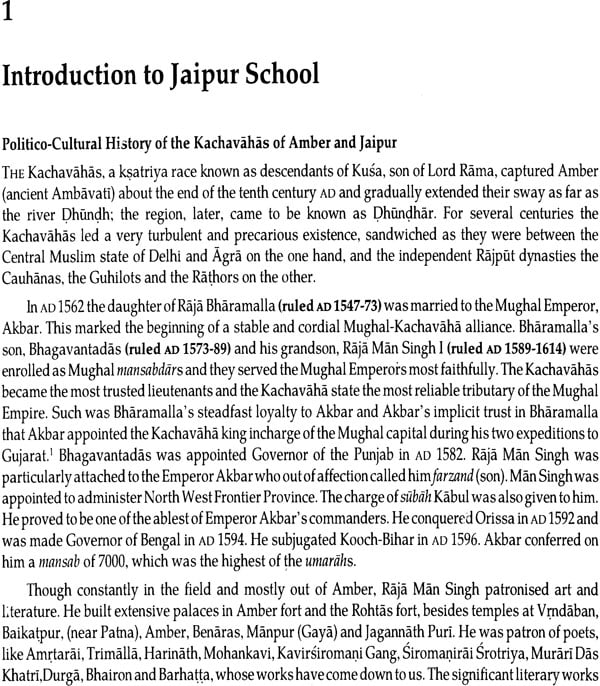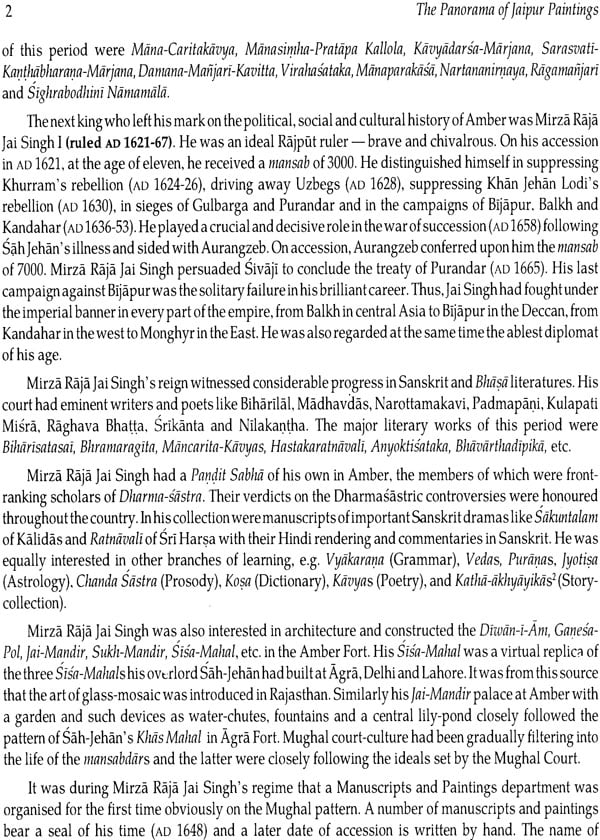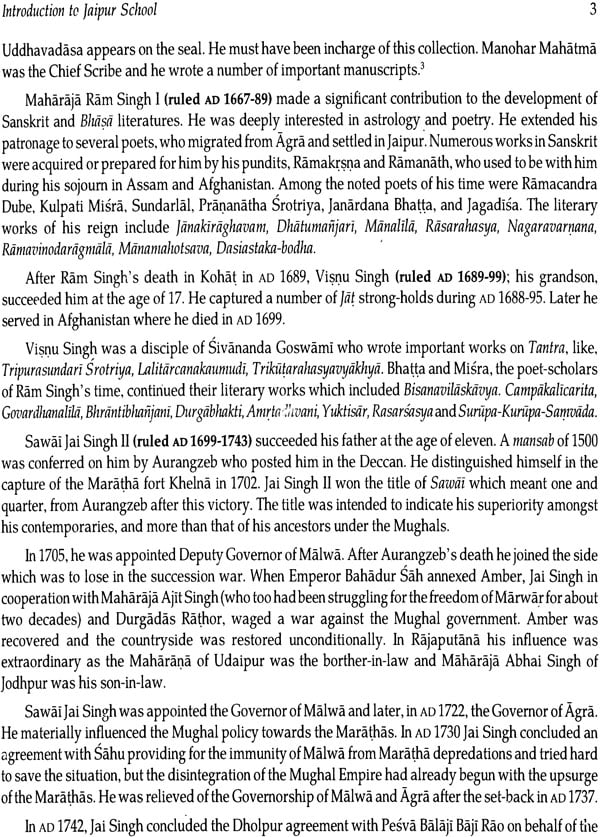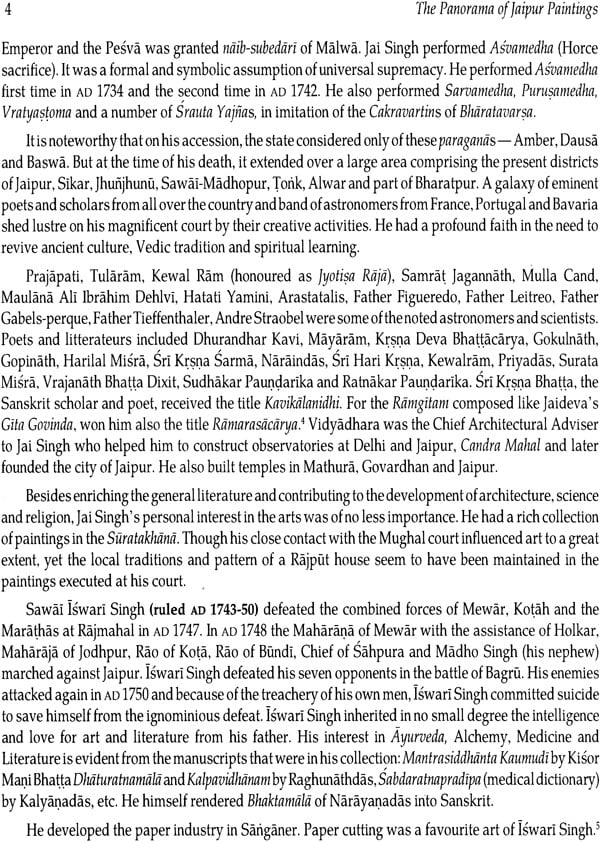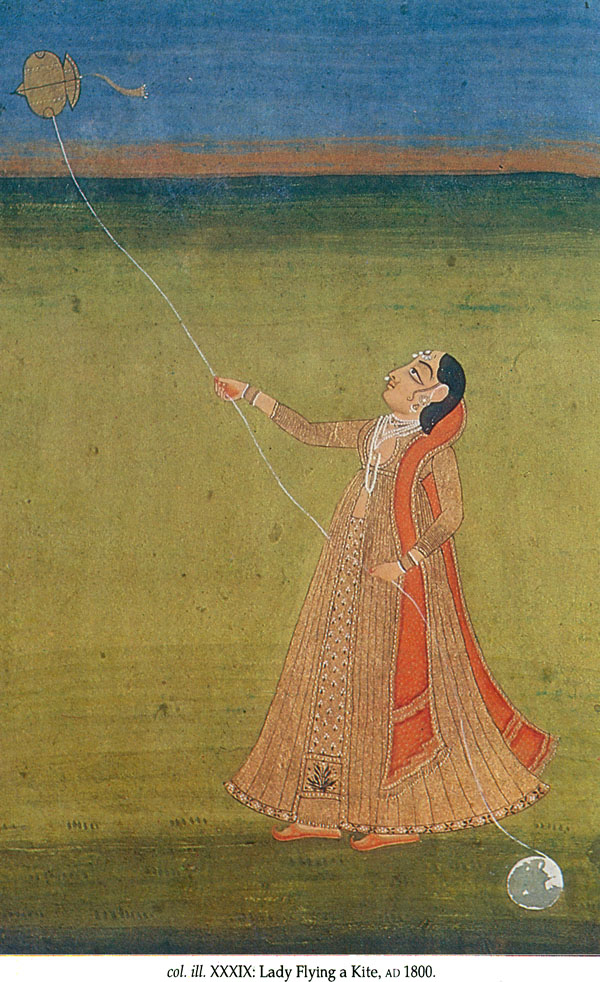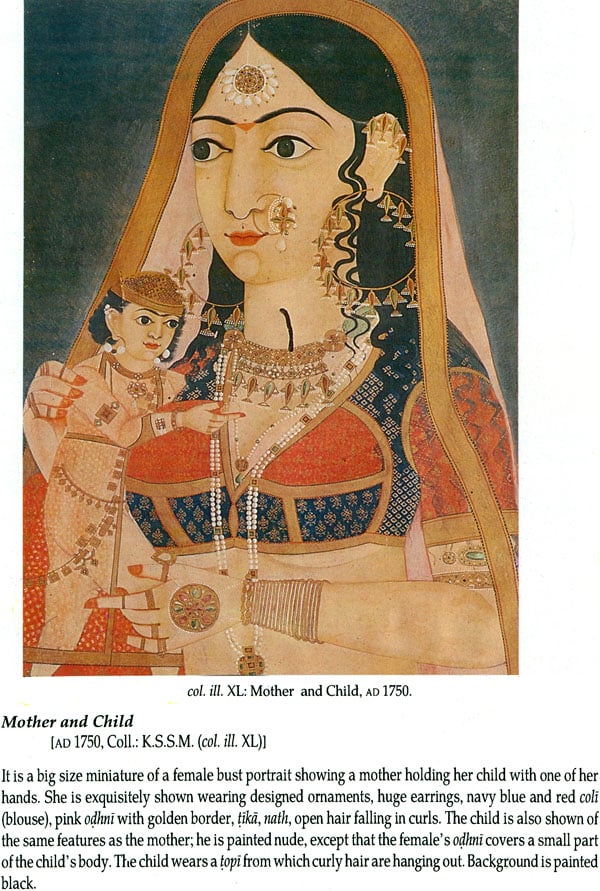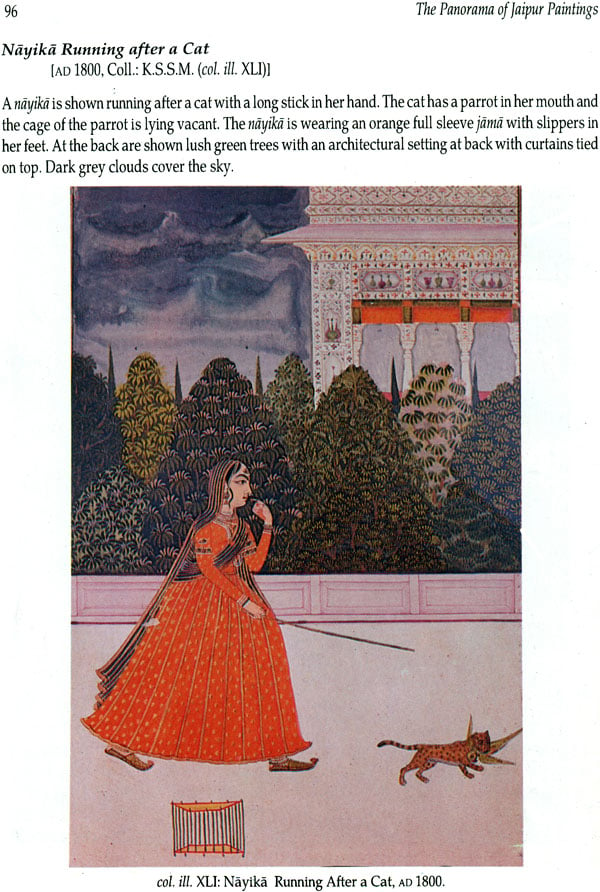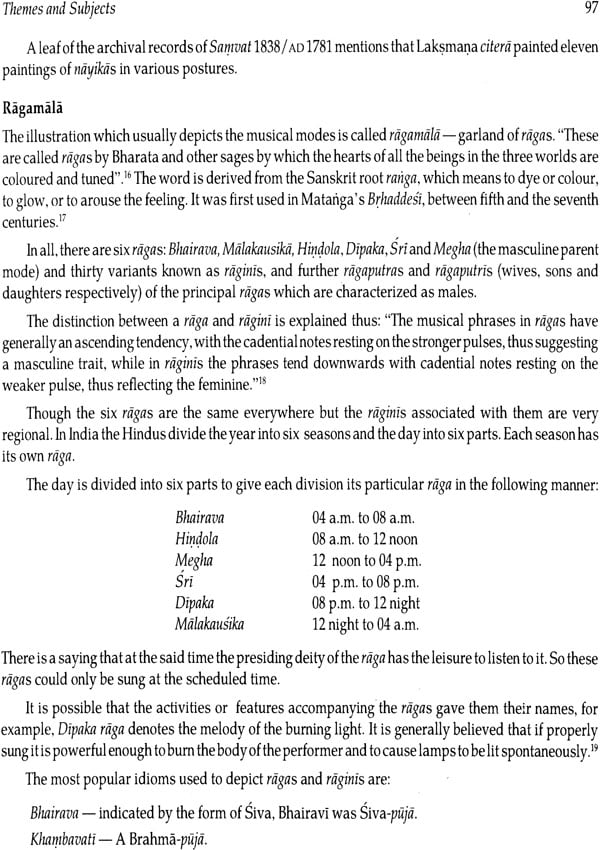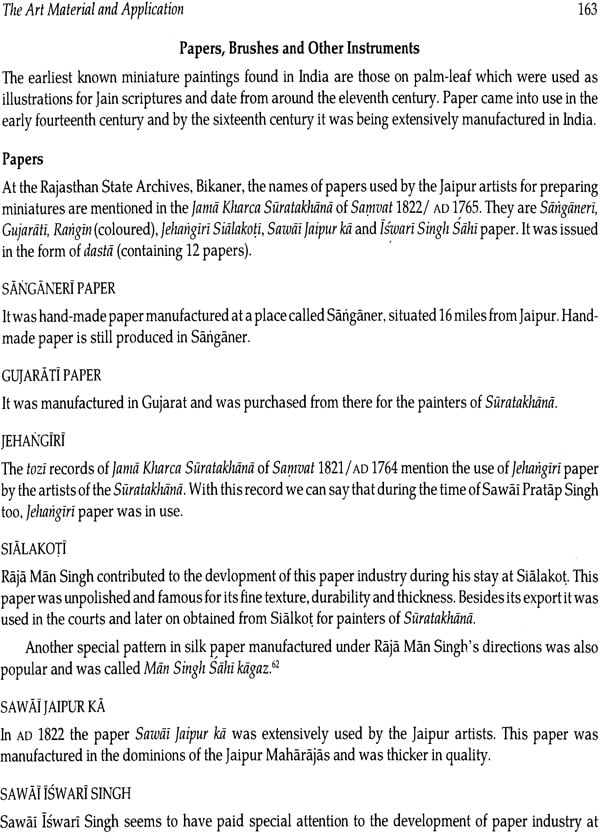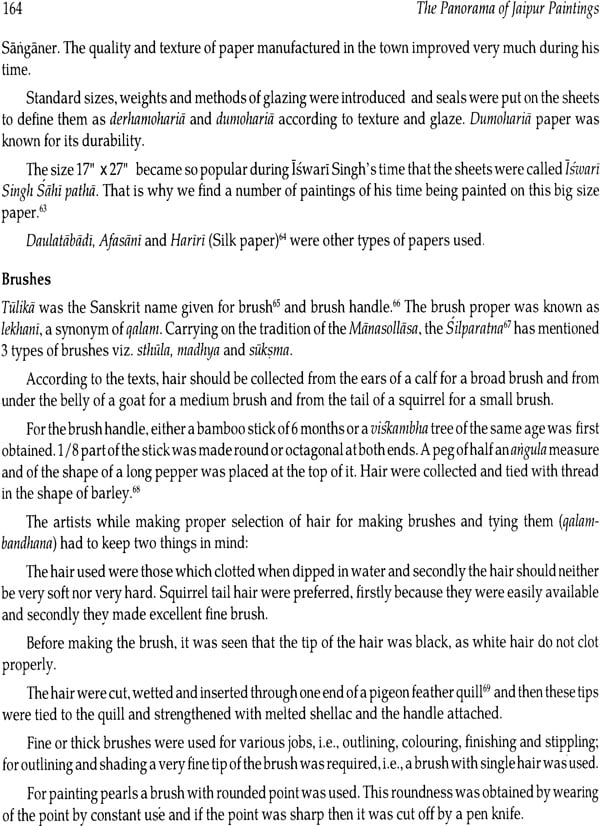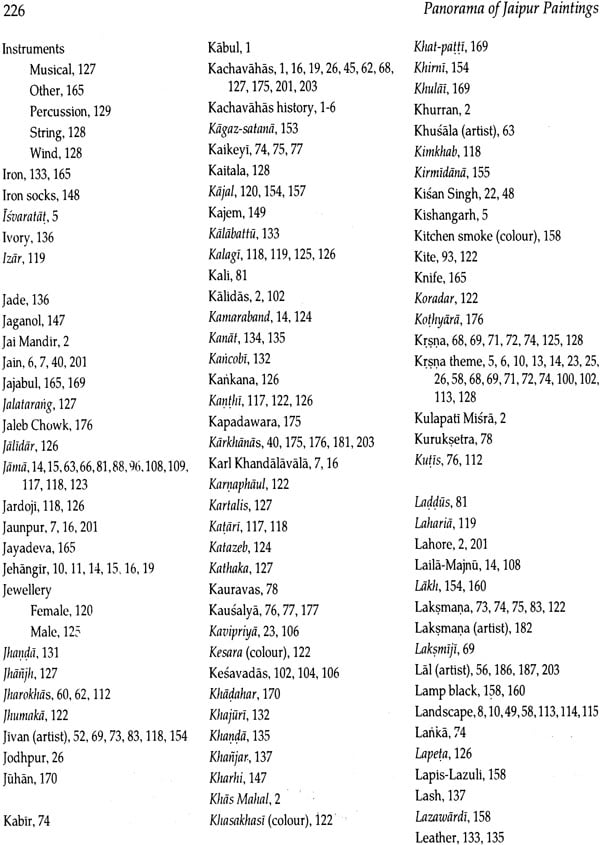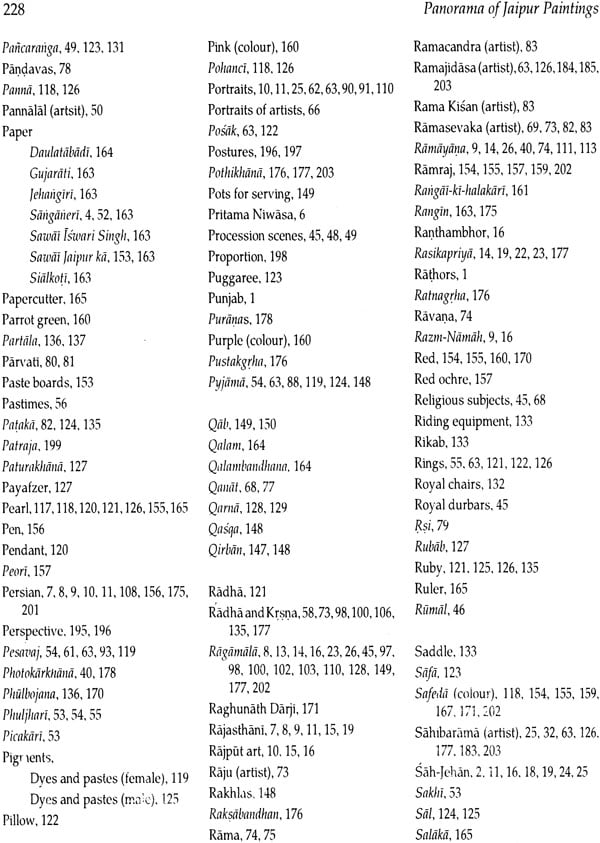
The Panorama of Jaipur Paintings
Book Specification
| Item Code: | IDD113 |
| Author: | Rita Pratap, With an Afterword by Mulk Raj Anand |
| Publisher: | D. K. Printworld Pvt. Ltd. |
| Language: | English |
| Edition: | 1996 |
| ISBN: | 8124600686 |
| Pages: | 234 (Illustrated in B/W and Color) |
| Cover: | Hardcover |
| Other Details | 11.0" X 8.8" |
| Weight | 1.40 kg |
Book Description
Back of the Book
Over the centuries, Indian art tradition came to have its differentiative regional, even local, specificities. For instance, the Jaipur School of Painting. Isolating itself from other Rajasthani genres like Mewar, Bikaner or Bundi, the Jaipur school set out its independent, distinctive identity, sometime during the early years of the 18 century. Historically, it was the time when the once-glorious Mughal empire was beginning to disintegrate and many of its court painters discovered, in Jaipur, a conducive have – under the generous patronage of Sawai Jai Singh (AD 1699-1743).
As the capital of Rajasthan, the erstwhile Rajputana, the erstwhile Rajputana, Jaipur evokes memories of Rajput chivalry, and legendary romance. And it unmistakably represents the beautiful in art and the magnificent in architecture – leave alone its fabulous cultural traditions. The School of Painting that thrived has here for over 150 years since Jain Singh’s time, covers a whole diversity of themes: both sacred and secular, evolving a veritable panorama of contemporary life and culture. And yet collectively, notwithstanding their exposure to the earliest character of Mughal art, Jaipur ministures are steeped in tradition – drawing inspiration from Indian mythology, epical/classical literature, and folklore.
For the first time, Dr. Rita Pratap offers an exclusive study of the Jaipur School of Miniature Painting, in all its different articulations-with focus, among other aspects, on its historical evolution; its style, forms and motifs; its artists and ateliers; and its linkages with other forms of creative expression: literature, music, sculpture, dance. For her meticulous analysis she has drawn on the miniatures from private collections and museums around the world.
Besides including bibliographic references and a glossary of non-English words, the book is embellished with representative specimens of Jaipur miniature paintings, exquisite figures and photographic reproductions in colour.
About the Author
Rita Pratap, Ph. D. (Rajasthan), is the 1952-born, freelance art critic and reputed painter, who today figures among the ten leading contemporary women artists of Rajasthan. A member of several art organizations, she has published a number of research studies, besides art reviews in Rajasthan’s newspapers. And some of her canvases have won awards and honours – at exhibitions : local, national and international.
Currently Assistant Professor of Drawing and Painting at the University of Rajasthan, Jaipur, Dr. Pratap has presented, analytical insights in her studies of the paintings and Wall paintings of Jaipur. Her other title, Galta – a tirath to be published shortly.
Preface
A systematic study of the Jaipur School of Miniature Painting has not been attempted so far. Erudite treatises on Rajput Paintings in general have been published from the time Coomaraswamy first brought it to light early this century. While some schools of Rajput paintings have been studied in detail, the Jaipur School remained largely obscured.
This research attempts to present a comprehensive account of the Kachavahas - the original inhabitants of Jaipur, the emergence and growth of Jaipur School of Painting and the interaction with the Mughals, the themes and techniques employed, the hitherto uncovered Jaipur Suratakhana, the details of the painters and their art and material cultural discerned from Jaipur miniatures.
An endeavour has been made to study the available paintings in various museums, the archival records, the literary texts and other documents on the art of Jaipur School. I have also tried to present a synoptic view of the evolution, growth and decline of Jaipur School of miniature painting. Textual details, notes on painting, material on style and technique have been included in the study.
I wish to express my deep sense of gratitude to Dr. R. Nath whose painstaking guidance and encouragement made this work possible.
I gratefully acknowledge the meaningful help and guidance I received from the staff of Rajasthan Sate Archives, Bikaner; the National Museum, New Delhi; the Prince of Wales Museum of Western India, Bombay; Museum and Picture Gallery, Baroda; Central Museum, Jaipur; Bharat Kala Bhawan, Benaras; and Sangram Singh Museum, Jaipur. I am thankful to them for permitting me to include photographs of their collection in my this monograph.
My thanks are also duet o Late Kumar Sangram Singh of Nawalagarh, Dr. A.K. Das, Dr. Ram Pande, Dr. Candrarmani Singh, Dr. C.S. Mehta, Padmasri Ram Gopal Vijaivargiya, Dr. Jai Singh Neeraj, Sri Mohan Lal Gupta, Sri Yadvendra Sahai, Late Dr. Satya Prakasa, Sri Gopal Narayan Bahura and Dr. G.N. Sarma for their constant guidance and suggestions.
I am also indebted to my mother Late Sarojini Vais and my family members for having encouraged me for this work.
Anand Pratap, my beloved husband, helped me in lending a broad perspective to the work, besides painstakingly correcting the text.
| Preface | vii | |
| Transliteration Chart | xi | |
| Chronology of Jaipur Rulers | xiii | |
| Abbreviations | xv | |
| List of Colour Illustrations and Figures | xix | |
| Map of Rajasthan | xxiii | |
| Antique Map of Jaipur | xxv | |
| 1 | INTRODUCTION TO JAIPUR SCHOOL | 1 |
| Politico-cultural History of the Kachavahas of Amber and Jaipur | ||
| The Indigenous Art of the Region | ||
| Mughal Painting and its Interaction with Rajasthani Painting | ||
| The Emergence and Blooming of Jaipur School Painting | ||
| 2 | THEMES AND SUBJECTS | 45 |
| Royal Durbars and Processions | ||
| Hunting and Battle Scenes | ||
| Festivals | ||
| Games and Pastimes | ||
| Portraits | ||
| Harem Scenes | ||
| Religious Subjects | ||
| Depiction of Common People | ||
| Nayikas | ||
| Ragamala | ||
| Baramasa Paintings | ||
| Other Subjects | ||
| Treatment of Themes and Subjects | ||
| Architecture and Landscape | ||
| 3 | MATERIAL CULTURE | 117 |
| Costumes and Jewellery | ||
| Musical Instruments | ||
| Insignia of Royalty | ||
| Furniture/Equipment | ||
| Arms and Armours | ||
| Utensils | ||
| 4 | THE ART MATERIAL AND APPLICATION | 153 |
| Preparation of Wasli (Paste-Boards) | ||
| Pigments and Colours | ||
| Binding Material | ||
| Papers, Brushes and Other Instruments | ||
| Technique of Application | ||
| Decoration of Border (Hasiyas) | ||
| Mounting of Paintings in Albums | ||
| 5 | SURATAKHANA | 175 |
| Organisation | ||
| Recorded Names of Artists | ||
| Hereditary Appointments | ||
| Salaries, Increments and Awards | ||
| Gifts to Maharajas | ||
| A Treatise on Painters | ||
| 6 | ART ANALYSIS | 195 |
| Delineation and Perspective | ||
| Postures (Sthanas) | ||
| Figure and Form | ||
| Proportion | ||
| Rekha and Bindu | ||
| 7 | JAIPUR SCHOOL - IN RETROSPECT | 201 |
| Appendix | 205 | |
| Glossary | 211 | |
| Bibliography | 215 | |
| Index | 223 | |
| Afterword | 231 |
